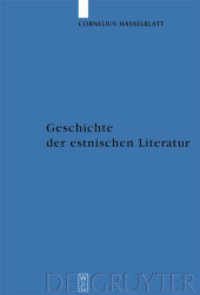- ホーム
- > 洋書
- > 英文書
- > Literary Criticism
Full Description
In this innovative re-casting of the genre and its received canon, Emily Horton explores fictional investments in the Gothic within contemporary British literature, revealing how such concepts as the monstrous, spectral and uncanny work to illuminate the insecure, uneven and precarious experience of 21st-century life. Reading contemporary works of Gothic fiction by Helen Oyeyemi, Kazuo Ishiguro, Sarah Moss, Patrick McGrath and M.R. Carey alongside writers not previously grouped under this umbrella, including Brian Chikwava, Chloe Aridjis and Mohsin Hamid, Horton illuminates the way the Gothic has been engaged and reread by contemporary writers to address the cultural anxieties invoked living under neocolonial and neoliberal governance, including terrorism, migration, homelessness, racism, and climate change.
Marshalling new modes of diasporic and cross-disciplinary critical theory concerned with the violent dimensions of contemporary life, this book sets the Gothic aesthetics in such works as White is for Witching, Double Vision, Never Let Me Go, The Wasted Vigil and Ghost Wall against a backdrop of key events in the 21st-century. Drawing connections between moments of anxiety, such as 9/11, the wars in Afghanistan and Iraq, ecological disaster, the refugee crisis, Brexit, the pandemic, and the Gothic, Horton demonstrates how British literature mediates transnational experiences of trauma and horror, while also addressing local and national insecurities and preoccupations. As a result, 21st-Century British Gothic can tests geographical, psychological, cultural, and aesthetic borders to expose an often spectralised experience of human and planetary vulnerability and speaks back against the brutality of global capitalism.
Contents
INTRODUCTION: 21st-Century British Gothic: The Monstrous, Spectral, and Uncanny in Contemporary Fiction
CHAPTER 1: Post-9/11 Gothic: The Uncanny and Contemporary Trauma in Pat Barker's Double Vision and Patrick McGrath's Ghost Town
CHAPTER 2: Decolonial Gothic: Tropical Terrors and Subterranean Ghosts in Tash Aw's The Harmony Silk Factory and Nadeem Aslam's The Wasted Vigil
CHAPTER 3: Gothic Inheritance: Imperial Witchcraft and Haunted Houses in Helen Oyeyemi's White is for Witching and Sarah Waters' The Little Stranger
CHAPTER 4: Digital Gothic: Digital Technology, Migration, and the Gothic in Hari Kunzru's Transmission and Mohsin Hamid's Exit West
CHAPTER 5: Gothic Homelessness: Spectral Inhabitants and Uncanny Spaces in Ali Smith's Hotel World, Trezza Azzopardi's Remember Me, and Brian Chikwava's Harare North
CHAPTER 6: The Gothic City: Uncanny spaces, historical spectres, and monstrous urbanity in Louise Welsh's The Cutting Room and Chloe Aridjis's Book of Clouds
CHAPTER 7: Brexit Gothic: Spectral Illusions and Affect Memories in Sarah Moss's Ghost Wall and Niall Griffith's Broken Ghost
CHAPTER 8: Pandemic Gothic: Childhood Terror and Monstrous Illness in the Fiction of Kazuo Ishiguro and M.R. Carey
CHAPTER 9: Wet Gothic: Ecofeminism and Horror in Julie Armfield's Our Wives Under the Sea, Daisy Johnson's Fen, and Zoe Gilbert's Folk
Bibliography
Index








